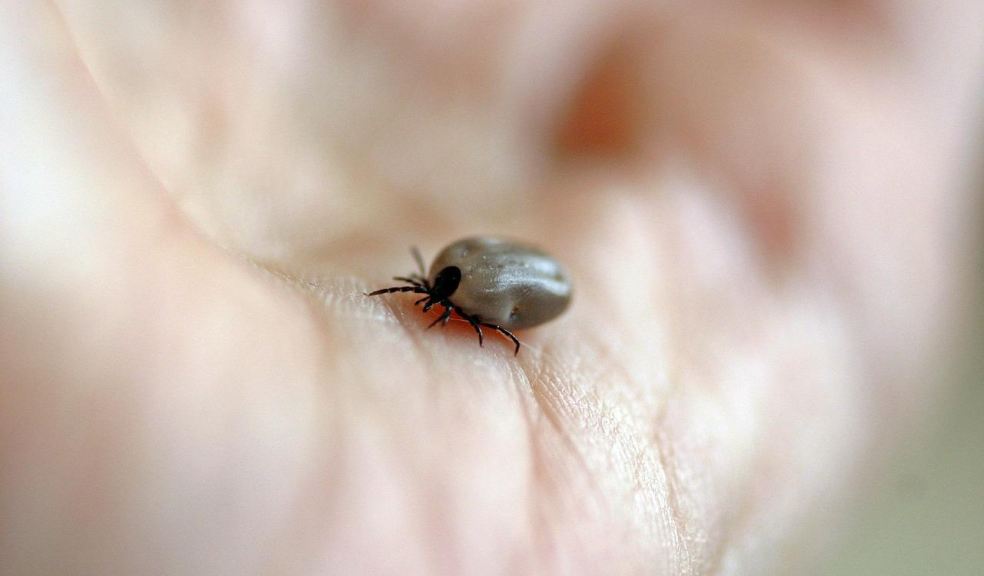
Public Health Devon warn of Lyme disease this tick season
Wetter weather earlier in the year followed by warmer, sunnier spells this month in Devon may make pets and people more prone to ticks when walking in woodlands or long vegetation, Public Health Devon warn.
“Ticks thrive in warmer weather and in lush vegetation,” says Steve Brown, Director of Public Health Devon. “And with warmer weather and people taking to the outdoors for recreation, woodlands and overgrown paths are likely to have ticks living among them.”
There are approximately 1,500 cases of Lyme disease, commonly spread by ticks, in England and Wales each year.
April to June is traditionally prime time tick season, and the level of cases of Lyme disease is routinely higher in Devon than England's average levels.
2022 figures are not yet available, but confirmed case levels of Lyme disease in Devon in 2021 were 5.6 cases per 100,000 of our population, compared to just an average 1.5 cases per 100,000 for England. The South West average last year was 3.5 cases per 100,000.
“Confirmed cases of Lyme disease in the South West, and Devon in particular, are usually a lot higher than the England average,” said Steve Brown.
“Lyme disease is a bacterial infection that can be spread to humans by infected ticks. It's usually easier to treat if it's diagnosed early.”
Ticks are small spider-like creatures, which feed on blood of host animals, including humans. They can vary in size, from the size of a small freckle to a baked bean.
Some can carry bacteria that pass diseases such as Lyme disease, so Public Health Devon say it’s important that people are aware of the risks and know what steps to take to reduce risk.
Early symptoms include a ‘bullseye’ rash around the site of the bite, and flu-like reactions such as fatigue, fever, chills or muscle aches.
Steve Brown said:
“Prevention and being prepared to respond quickly is the best form of protection against these diseases, as removing a tick promptly reduces the risk of infection.
“Typically, ticks are found in dense vegetation and woodland areas, as it offers them protection.
“Walking on defined paths, covering up as much as possible, wearing light coloured clothing so that they’re easier to spot and wearing an insect repellent that can deter ticks* from climbing onto skin, are all sensible precautions.
“And it’s important to carry out regular tick checks after any outdoors activity, as spotting them early allows you to act promptly.”
The experts’ advice on removing ticks is to use fine headed tweezers, or a tick removal tool, to hold onto the tick as close to the skin as possible. Then, slowly pull upwards. This will remove the whole tick at once, avoiding infection. After, the site should be cleaned with an antibacterial wipe.
If that wasn’t successful and you’re worried you haven’t removed the entire tick, or you suffer symptoms after a tick bite, you should contact 111, visit your GP or an A&E minor injuries unit.
Neil, from Exeter, did just that with his son, George.
“I was a bit concerned as there was still something attached to my son’s body. My wife told me it was a tick and I shouldn’t have pulled at it. We decided to take George to A&E as we couldn’t remove all the tick and we were then concerned about infection. The remaining piece was removed at A&E with a scalpel!’
George thankfully didn’t go on to contract any further infection, nor require any further treatment.
Liz, from the Holsworthy area, also took steps after returning from holiday in Spain:
“When I returned, I found I had little energy. I even had to pull over in the car and sleep for fear of falling asleep at the wheel. I thought I was going down with a virus and tried to shake it off with painkillers.
“A few weeks after my return from holiday I noticed a red mark on the back of my leg. It didn’t itch but it was quite large and like a ring with a red mark in the centre it looked like a bulls eye!
“The GP confirmed Lyme disease from an infected tick and prescribed a month’s course of antibiotics.”
After the antibiotics, Liz began to regain her strength and thankfully hasn’t suffered from any long term symptoms.
Find out more information on tick awareness and Lyme disease you can read this blog written by the government or visit the NHS website.
*Some insect repellents are effective against ticks, but some can also be harmful to pets. Please read the instructions before use.











